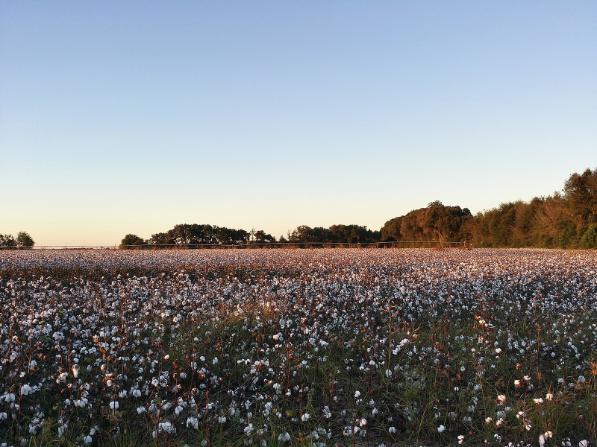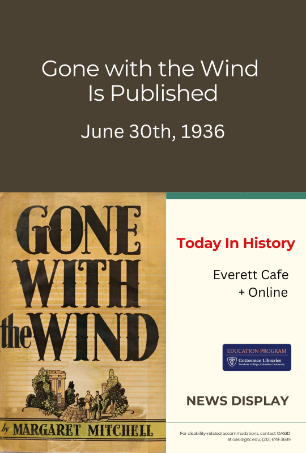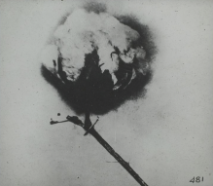Today In History: Gone with the Wind Is Published

Spring had come early that year, with warm quick rains and and sudden frothing of pink peach blossoms and dogwood dappling with white stars the dark river swamp and far-off hills. Already the plowing was nearly finished, and the bloody glory of the sunset colored the fresh-cut furrows of Georgia clay to even redder hues. The moist hungry earth, waiting upturned for the cotton seeds, showed pinkish on the sandy tops of the furrows, vermilion and scarlet and maroon where shadows lay along the sides of the trenches. The whitewashed brick plantation house seemed an island set in a wild red sea, a sea of spiraling, curling, crescent billows petrified suddenly at the moment when the pink-tipped waves were breaking into surf. For here were no long, straight furrows, such as could be seen in the yellow clay fields of the flat middle Georgia country or in the lush black earth of the coastal plantations. The rolling foothill country of north Georgia was plowed in a million curves to keep the rich earth from washing down into the river bottoms.
It was a savagely red land, blood colored after rains, brick dust in droughts, the best cotton land in the world. It was a pleasant land of white houses, peaceful plowed fields and sluggish yellow rivers, but a land of contrasts, of brightest sun and densest shade. The plantation clearings and miles of cotton fields smiled up to a warm sun, placid, complacent. At their edges rose the virgin forests, dark and cool, even in the hottest noons, mysterious, a little sinister, the soughing pines seeming to wait with an ageold patience, to threaten with soft sighs: "Be careful! Be careful! We, had you once. We can take you back again."
-- Margaret Mitchell, Gone With the Wind, p.8.
A once-thriving cotton plantation near Atlanta, Georgia, Tara was the fictional setting of Gone With the Wind, an historical romance published to great acclaim on June 30th, 1936 by MacMillan. Margaret Mitchell's lengthy novel depicts the impact of the Civil War and Reconstruction Period, following the efforts of Scarlett O'Hara, daughter to Gerald O'Hara, a wealthy Irish immigrant, to endure hardship and survive. It explores complex racial issues, with Tara symbolizing resilience and the South, embodied by the petulant belle who loses her true love, Rhett Butler; her daughter Bonnie; her mother Helen; and her home, pillaged and damaged by Union soldiers, and later set on fire. While the novel has been criticized for its stereotypical and demeaning portrayal of African Americans, it has sold over 30 million copies and been translated into 25 languages. It was released by Selznick International Pictures in 1939, starring Vivian Leigh and Clark Gable -- also a highly acclaimed production that earned ten Academy Awards.
The following articles are drawn from Proquest Historical Newspapers, which informs and inspires classroom teaching and learning.
- The Real Story of "Gone With the Wind": As Told by Margaret Mitchell to Norman S. Berg. (1936, Nov 29). The Atlanta Constitution (1881-1945)
- Weeks, E. W. (1936, Dec 20). What Makes a Book a Best Seller?: The Phenomenal Success of "Gone With the Wind" Prompts Some Reflections on Popular Novels of Yesterday and Today What Makes a Best Seller? New York Times (1923-)
- Hicks, G. (1976, Oct 03). Margaret Mitchell's 'Gone With the Wind' Letters 1936-1949. New York Times (1923-)
- McDowell, E (1981, Jul 05). Reading and Writing Not Gone With the Wind. New York Times (1923-)
- 'Gone With the Wind ' at 50: Civil War Novel of 1936 Now Is a Timeless Classic. The Sun (1837-)
- McKelvey, B. (1986, Jun 30). 50 Years Later: The Marvel Novel Gone With the Wind. The Hartford Courant (1923-)
- Ingrassia, M. (1987, Feb 13). Gone With the Wind: The Sequel: New Novel in the Works. Newsday (1940-)
- Finkle, D. (1989, Dec 10). Tara! Tara! Tara!: Gone With the Wind: The Definitive Illustrated History of the Book, the Movie, and the Legend. New York Times (1923-)
- Cox, M. (1990, Jun 13). Delay in 'Gone With the Wind' Sequel Sparks Rumors: Publishing. Wall Street Journal (1923-)
- Schuessler, J. (2020, Jun 15). Giving More Than a Damn: Blacks Have Protested the Racism in 'Gone With the Wind' Since the Very Start. New York Times (1923-)

Tips:
- Bauer, Margaret Donovan. A Study of Scarletts : Scarlett O’Hara and Her Literary Daughters. 1st ed., The University of South Carolina Press, 2014. e-book.
- Buell, Lawrence. The Dream of the Great American Novel. 1st ed., Belknap Press of Harvard University Press, 2014. e-book.
- Dickey, Jennifer W., and Liz Lester. A Tough Little Patch of History : Gone with the Wind and the Politics of Memory. 1st ed., The University of Arkansas Press, 2014. e-book.
- Hanson, Elizabeth I. Margaret Mitchell. Twayne Publishers, 1990. e-book.
- Haskell, Molly. Frankly, My Dear : Gone with the Wind Revisited. 1st ed., Yale University Press, 2009. e-book.
- Margaret Mitchel and Her Novel Gone With the Wind. New York : Macmillan, 1936. e-pamphlet.
- Mitchell, Margaret. Gone With the Wind. New York : Macmillan, 1936. CUL Rare Books. PS3525.I972 G6 1936.
- Mitchell, Margaret. Gone With the Wind. New York : Macmillan, 1936. e-book via Central Library, University of Delhi, Internet Archive.
- Talley, Sharon. Southern Women Novelists and the Civil War : Trauma and Collective Memory in the American Literary Tradition since 1861. First edition., The University of Tennessee Press, 2014. e-book.

Images:
- South Georgia Cotton Field, by Jeffrey Hatcher, 2014. Courtesy of Wikimedia Commons.
- Poster Image: Book Cover for the First Edition of Gone with the Wind, 1936. Courtesy of Wikimedia Commons.
- Cotton Ball, 1930. Rothman Lantern Slide Collection, Courtesy of Teachers College, Columbia University.
Need to keep current, look to the past, teach a topic? The Everett Cafe features daily postings of news from around the world, and also promotes awareness of historical events from an educational context. Be sure to check additional Cafe News postings on the library blog.

